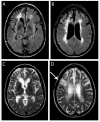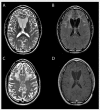Genetic Leukoencephalopathies in Adults
- PMID: 27261689
- PMCID: PMC5617213
- DOI: 10.1212/CON.0000000000000338
Genetic Leukoencephalopathies in Adults
Abstract
Purpose of review: More than 100 heritable disorders can present with abnormal white matter on neuroimaging. While acquired disorders remain a more common cause of leukoencephalopathy in the adult than genetic causes, the clinician must remain aware of features that suggest a possible genetic etiology.
Recent findings: The differential diagnosis of heritable white matter disorders in adults has been revolutionized by next-generation sequencing approaches and the recent identification of the molecular cause of a series of adult-onset disorders.
Summary: The identification of a heritable etiology of white matter disease will often have important prognostic and family counseling implications. It is thus important to be aware of the most common hereditary disorders of the white matter and to know how to distinguish them from acquired disorders and how to approach their diagnosis.
Figures










Similar articles
-
AARS2-related ovarioleukodystrophy: Clinical and neuroimaging features of three new cases.Acta Neurol Scand. 2018 Oct;138(4):278-283. doi: 10.1111/ane.12954. Epub 2018 May 10. Acta Neurol Scand. 2018. PMID: 29749055
-
Mitochondrial leukoencephalopathies: A border zone between acquired and inherited white matter disorders in children?Mult Scler Relat Disord. 2018 Feb;20:84-92. doi: 10.1016/j.msard.2018.01.003. Epub 2018 Jan 6. Mult Scler Relat Disord. 2018. PMID: 29353736
-
Inherited leukoencephalopathies with clinical onset in middle and old age.J Neurol Sci. 2014 Dec 15;347(1-2):1-13. doi: 10.1016/j.jns.2014.09.020. Epub 2014 Sep 20. J Neurol Sci. 2014. PMID: 25307983 Review.
-
The spectrum of adult-onset heritable white-matter disorders.Handb Clin Neurol. 2018;148:669-692. doi: 10.1016/B978-0-444-64076-5.00043-0. Handb Clin Neurol. 2018. PMID: 29478607
-
Brain Calcifications in Adult-Onset Genetic Leukoencephalopathies: A Review.JAMA Neurol. 2017 Aug 1;74(8):1000-1008. doi: 10.1001/jamaneurol.2017.1062. JAMA Neurol. 2017. PMID: 28628708 Review.
Cited by
-
Clinical presentation and diagnosis of adult-onset leukoencephalopathy with axonal spheroids and pigmented glia: a literature analysis of case studies.Front Neurol. 2024 Mar 11;15:1320663. doi: 10.3389/fneur.2024.1320663. eCollection 2024. Front Neurol. 2024. PMID: 38529036 Free PMC article.
-
An adolescence-onset male leukoencephalopathy with remarkable cerebellar atrophy and novel compound heterozygous AARS2 gene mutations: a case report.J Hum Genet. 2018 Jul;63(7):841-846. doi: 10.1038/s10038-018-0446-7. Epub 2018 Apr 17. J Hum Genet. 2018. PMID: 29666464
-
The disappearance of white matter in an adult-onset disease: a case report.BMC Psychiatry. 2020 Mar 27;20(1):137. doi: 10.1186/s12888-020-02551-x. BMC Psychiatry. 2020. PMID: 32220229 Free PMC article.
-
Natural History of Vanishing White Matter.Ann Neurol. 2018 Aug;84(2):274-288. doi: 10.1002/ana.25287. Epub 2018 Sep 6. Ann Neurol. 2018. PMID: 30014503 Free PMC article.
-
Case Report: Mutation in AIMP2/P38, the Scaffold for the Multi-Trna Synthetase Complex, and Association With Progressive Neurodevelopmental Disorders.Front Genet. 2022 Jan 24;13:816987. doi: 10.3389/fgene.2022.816987. eCollection 2022. Front Genet. 2022. PMID: 35140751 Free PMC article.
References
-
- Vanderver A, Tonduti D, Schiffmann R, et al. Leukodystrophy overview. In: Pagon RA, Adam MP, Ardinger HH, et al., eds. GeneReviews. Seattle, WA: University of Washington, Seattle; 2014:1993–2016. www.ncbi.nlm.nih.gov/books/NBK184570/?report=reader. Accessed April 3, 2016. - PubMed
-
- Steenweg ME, Salomons GS, Yapici Z, et al. L-2-Hydroxyglutaric aciduria: pattern of MR imaging abnormalities in 56 patients. Radiology 2009;251(3):856–865. doi:10.1148/radiol.2513080647. - PubMed
-
- van der Knaap MS, van der Voorn P, Barkhof F, et al. A new leukoencephalopathy with brainstem and spinal cord involvement and high lactate. Ann Neurol 2003;53(2):252–258. doi:10.1002/ana.10456. - PubMed
-
- Scheper GC, van der Klok T, van Andel RJ, et al. Mitochondrial aspartyl-tRNA synthetase deficiency causes leukoencephalopathy with brain stem and spinal cord involvement and lactate elevation. Nat Genet 2007;39(4):534–539. doi:10.1038/ng2013. - PubMed
Publication types
MeSH terms
LinkOut - more resources
Full Text Sources
Other Literature Sources
Research Materials
